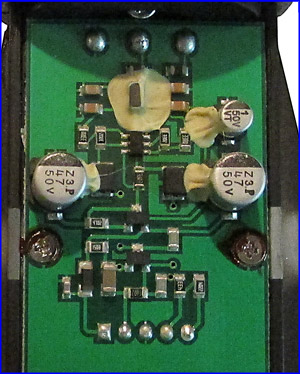MICROPHONES
North Suburban HAMMOND ORGAN Service
The secret to the success of the condenser microphone is the special preamplifier which is included right inside the microphone case, and which not only amplifies the tiny signal from the microphone capsule assembly but also delivers the signal at a much lower impedance which is compatible with most standard microphone cables. This low impedance amplified signal can travel perfectly well through long microphone cables without any significant quality losses. The distance between the actual microphone capsule and the input to the preamp is usually not over two inches, and the capsule signal never travels a greater distance than that. In fact it never even leaves the inside of the microphone case.

Figure 9. A microphone preamplifier installed inside the case of the condenser mic shown in figure eight on the previous page. It greatly increases the level of the minute signal from the microphone capsule and also changes the impedance to be compatible with standard microphone cable hookups.
Because condenser microphones need to have the polarizing voltage applied to the microphone capsule and because they also contain the necessary preamplifier, these microphones need a source of DC power. There are two ways that this is done. One way is to include a battery compartment in the microphone, and the second way, which is usually the preferred method, is to supply phantom power for the condenser microphones along the same cables that convey the microphone signals out of the mics. Phantom power is generally (but not exclusively) standardized at 48 volts DC. It is usually supplied from either the mixers or the multi-track recorders to which the microphones are connected.
The application of phantom power to a condenser mic over the same wires that carry the microphone signal to the device that the mic is connected to is one of the many examples in modern electronic equipment where direct current and alternating current coexist in the same circuitry and travel over the same wires.
The fact that these microphones are generally connected to mixers or to multi-track recorders is [my opinion] somewhat of a tacit implication that such mics are generally intended for professional music or recording situations as opposed to casual home recording. Figure nine presents the mic preamp in a condenser microphone with its casing removed. This clearly shows the preamplifier which is an integral part of the complete microphone. The microphone in figure eight on the previous page, and also on this page is designed to be powered by 48 volt DC from whatever device the mic is connected.
Some condenser microphones are known as electret mics. In a sense, an electret material is like a permanent magnet in that an initial charge is placed on the electret element during manufacture, and it remains there indefinitely. The word electret is a combination of electrostatic and magnet. Other condenser mics get their charging voltage from the phantom power supply. But in either instance, whether a condenser mic capsule uses the electret principle or whether it gets the charge externally, all condenser mics need DC power for the internal preamps, and thus all of them either require a built-in battery compartment or a connection to phantom power regardless of the capsule design.
Page 6. Previous page | Next page